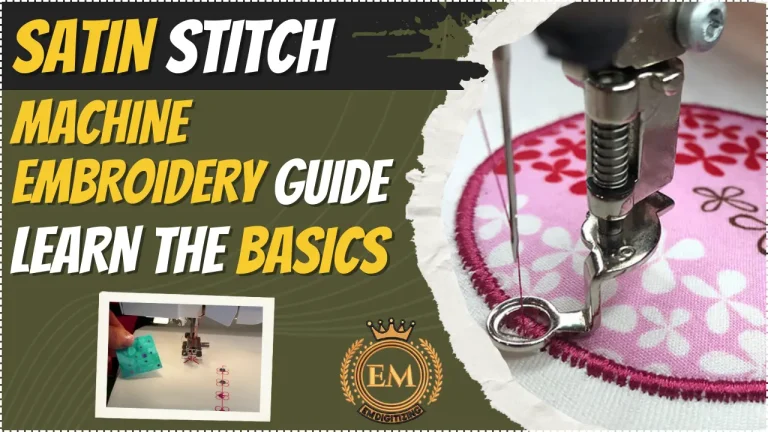Satin Stitch Machine Embroidery Guide: Learn The Basics

Embroidery is an art form that has stood the test of time, adding beauty and personalization to textiles for centuries. Among the various embroidery techniques, the satin stitch stands out for its smooth, glossy finish, making it a popular choice for monograms, logos, and intricate designs. In this guide, we will explore the basics of satin stitch machine embroidery, offering tips and insights to help you master this technique. Additionally, we’ll discuss how embroidery digitizing services can elevate your satin stitch projects, ensuring precision and professionalism.
What is Satin Stitch Embroidery?
1. Definition and Characteristics
The satin stitch, also known as the damask stitch, is a series of closely placed parallel stitches that create a smooth, satin-like finish. It is widely used for filling in shapes and creating bold outlines in machine embroidery.
2. Uses of Satin Stitch
Satin stitch is versatile and commonly used for:
- Monograms and Initials: Ideal for adding a personal touch to garments and accessories.
- Logos and Branding: Frequently used in corporate and promotional embroidery.
- Decorative Elements: Perfect for embellishing designs with a luxurious sheen.
Materials Needed for Satin Stitch Embroidery
Before starting your satin stitch project, gather the following materials:
- Embroidery Machine: A reliable machine with satin stitch capabilities.
- Embroidery Thread: High-quality thread in your desired colors.
- Fabric: Choose a fabric suitable for machine embroidery.
- Stabilizer: Essential for providing support and preventing fabric distortion.
- Embroidery Needle: Ensure you have the correct needle for your fabric and thread.
- Embroidery Design: A digitized design suitable for satin stitching.
Step-by-Step Guide to Satin Stitch Embroidery
Step 1: Preparing Your Design
Select a design that is suitable for satin stitching. If you’re not confident in creating your own design, consider using embroidery digitizing services to convert your artwork into a machine-friendly format.
Step 2: Hoop the Fabric and Stabilizer
Place the fabric and stabilizer in the embroidery hoop, ensuring they are taut and smooth. The stabilizer is crucial for maintaining the fabric’s shape during stitching.
Step 3: Thread the Machine
Choose the appropriate embroidery thread and thread your machine according to the manufacturer’s instructions. Satin stitch often requires multiple colors, so prepare all necessary threads in advance.
Step 4: Load the Design
Load your digitized design into the embroidery machine. Make sure it is properly aligned and scaled to fit the hoop.
Step 5: Start Embroidering
Begin the embroidery process. The machine will stitch out the satin stitches according to the digitized design. Monitor the process to ensure everything is running smoothly and make any necessary adjustments.
Step 6: Finish and Trim
Once the embroidery is complete, carefully remove the hoop and trim any excess threads. Remove the stabilizer as per the manufacturer’s instructions.
Tips for Perfect Satin Stitch Embroidery
1. Choose the Right Thread
Using high-quality embroidery thread is essential for achieving a smooth, glossy finish. Rayon and polyester threads are popular choices for their sheen and durability.
2. Use a Stabilizer
A stabilizer is non-negotiable when it comes to satin stitch embroidery. It prevents puckering and distortion, ensuring your stitches remain even and smooth.
3. Adjust Tension Settings
Proper tension settings are crucial for satin stitch embroidery. Too tight, and your fabric may pucker; too loose, and your stitches may be uneven. Test your settings on a scrap piece of fabric before starting your digitizing for embroidery project.
4. Practice on Scrap Fabric
Before embroidering your final piece, practice on a scrap piece of fabric. This helps you get a feel for the machine settings and stitch placement.
5. Utilize Embroidery Digitizing Services
Digitizing a design for satin stitch can be complex. Embroidery digitizing services can ensure your design is perfectly converted, optimizing stitch placement and density for the best results.
Common Challenges and Solutions
1. Puckering Fabric
Puckering is often caused by insufficient stabilization or incorrect tension settings. Ensure you are using the right stabilizer and adjust your machine’s tension settings as needed.
2. Uneven Stitches
Uneven stitches can result from inconsistent fabric tension or poor digitization. Make sure your fabric is taut in the hoop and consider using professional digitizing services for complex designs.
3. Thread Breakage
Thread breakage can be frustrating and is usually caused by poor-quality thread, incorrect needle size, or improper tension. Use high-quality thread, the correct needle, and check your machine’s tension settings.
Advanced Techniques for Satin Stitch Embroidery
1. Variegated Threads
Using variegated threads can add a unique, multicolored effect to your satin stitch embroidery, enhancing the visual interest of your design.
2. Gradient Effects
Create gradient effects by gradually changing thread colors within the design. This technique requires careful planning and precise execution.
3. Combining Stitches
Combine satin stitches with other stitch types, such as fill stitches or backstitches, to add texture and depth to your embroidery.
Case Study: Successful Satin Stitch Project
The Project
A client requested a set of personalized monogrammed handkerchiefs with intricate satin stitch designs. The monograms included fine details and required precise execution.
The Approach
The digitizing service carefully analyzed the design, ensuring proper push and pull compensation. They selected high-quality rayon threads and used a water-soluble stabilizer to prevent puckering.
The Result
The finished handkerchiefs featured crisp, smooth satin stitches with no distortion. The monograms were elegant and professional, showcasing the high quality of the digitizing and embroidery process.
Conclusion
Mastering satin stitch machine embroidery opens up a world of creative possibilities. With the right materials, techniques, and a little practice, you can create stunning, professional-quality embroidery. Leveraging embroidery digitizing services can further enhance your projects, ensuring precision and saving you time. Remember, practice makes perfect – so keep experimenting and refining your skills to achieve the best results.
FAQs
What is satin stitch embroidery?
Satin stitch embroidery is a technique that uses closely placed parallel stitches to create a smooth, glossy finish. It is commonly used for monograms, logos, and decorative elements.
Why is a stabilizer important for satin stitch embroidery?
A stabilizer prevents fabric distortion and puckering, ensuring that your stitches remain smooth and even. It provides essential support during the embroidery process.
How can embroidery digitizing services help with satin stitch projects?
Embroidery digitizing services convert your designs into machine-friendly formats, optimizing stitch placement and density for professional-quality results.
What are some tips for achieving perfect satin stitches?
Using high-quality thread, the right stabilizer, and proper tension settings are crucial. Practicing on scrap fabric and utilizing professional digitizing services can also help.
What are some advanced techniques for satin stitch embroidery?
Advanced techniques include using variegated threads, creating gradient effects, and combining satin stitches with other stitch types to add texture and depth.







